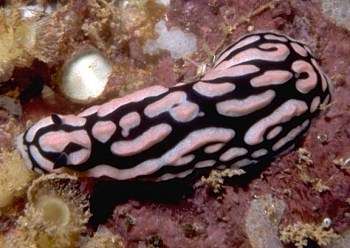
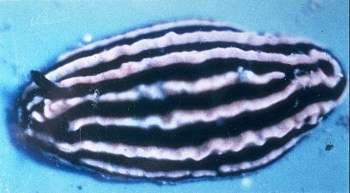
Phyllidiella rosans
(Bergh, 1873)
Order: NUDIBRANCHIA
Suborder: DORIDINA
Superfamily: EUDORIDOIDEA
Family: Phyllidiidae
DISTRIBUTION
Known from Tahiti, Hawaii, the western Pacific Ocean and the Indian Ocean.
PHOTO
12 m depth, Pupukea, Oahu, Hawaii, 29 June 1983, dorsal view of 18 mm specimen (with smooth, broken ridges), Photo: S. Johnson (Brunckhorst, 1993: Plate 6C); 1-20 m depth, Réunion, Indian Ocean, 1989, dorsal view of 35 mm specimen, Photo: M. Jay (Brunckhorst, 1993: Plate 6D).
Notes compiled from Brunckhorst, 1993:
Phyllidiella rosans is distinguished by its numerous, longitudinal, rounded pink ridges, pink margin and black rhinophores which have a pink stalk. Ventrally, P. rosans is pale grey.
The longitudinal notal ridges of the present species distinguish it from the three species of Phyllidiella described above and also the new species described below. The only other species of Phyllidiella which possesses longitudinal ridges and a pale foot is Phyllidiella zeylanica. However, that species differs from P.rosans in the very uneven, irregular nature of the notal ridges which are formed from the coalesced bases of compound tubercles. Furthermore, the foot of P. zeylanica is whitish and its gills and oral tentacles are dark grey (pale in P. rosans). Each rhinophoral clavus possesses 20-23 lamellae in P. zeylanica (specimens greater than 30 mm), but only 12-15 in P. rosans (specimens greater than 30 mm).
Reference:
• Brunckhorst, D.J. (1993) The systematics and phylogeny of Phyllidiid Nudibranchs (Doridoidea). Records of the Australian Museum, Supplement 16: 1-107.
Rudman, W.B., 1999 (September 12) Phyllidiella rosans (Bergh, 1873). [In] Sea Slug Forum. Australian Museum, Sydney. Available from http://www.seaslugforum.net/find/phylrosa
Related messages
Phyllidiella rosans from the Maldives
July 23, 2008
From: Alberto Ricci
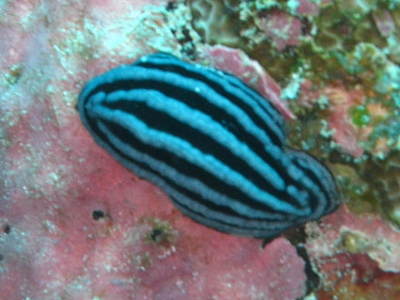
Dear Prof. Rudman,
Congratulations for all the work and enthusiasm you put into the research on sea slugs.
While diving in the South Ari atoll of the Maldives, I took a picture of what I think is a Phyllidiopsis striata or Phyllidiopsis annae, but which appears to differ slightly from the description you provide.
Length: around 3 cm. Location: N 3 28' 09", E 72 49' 59". Depth: 12 m.
Date: 27 December 2007, 10:54 AM.
I would be very grateful if you would help me identify it! Thank you
very much again.
Best regards
Alberto Ricci.
alberto@ovolab.com
Ricci, A., 2008 (Jul 23) Phyllidiella rosans from the Maldives. [Message in] Sea Slug Forum. Australian Museum, Sydney. Available from http://www.seaslugforum.net/find/21731Dear Alberto,
I am pretty sure this is Phyllidiella rosans which Nathalie Yonow reports to be common in the Maldives (Yonow, et al, 2002). As the name suggests, P. rosans is characterised by its pink ridges, but as with other species of Phyllidiella, it appears to change colour from pink to green.
-
Yonow, N., Anderson, R. C., and Buttress, S. G. (2002) Opisthobranch molluscs from the Chagos Archipelago, Central Indian Ocean . Journal of Natural History 36: 831-882 .
Best wishes,
Bill Rudman
Phyllidiella rosans mating - D. denisoni hiding
February 15, 2007
From: Hugues Flodrops
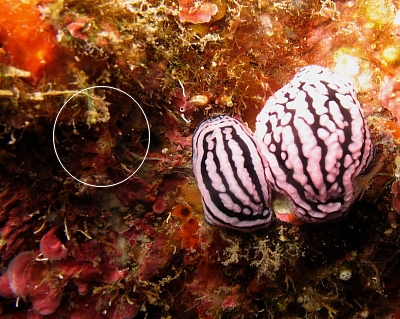
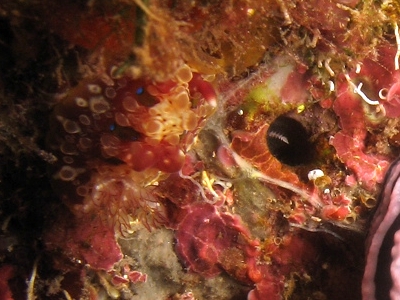
Dear Bill,
If you look closely, you can see three seaslugs in this picture. When I was looking at this photo I took of two Phylidiella rosans mating, [approx 25 mm & 40 mm], I saw on the computer a blue spot on the left and after I enlarged it, a juvenile Dendrodoris denisoni (size about 20-25 mm) was clearly visible.The red sponge was a good camouflage for it.
Could you confirm the identification?
Locality: Pain de Sucre, Saint-Gilles, 15 metres, Reunion Island, Indian Ocean, 20 December 2006. Length: 25 mm- 40 mm- 20 mm. Photographer: Hugues Flodrops.
With kind regards.
Hugues.
hugues.flodrops@wanadoo.fr
Flodrops,H., 2007 (Feb 15) Phyllidiella rosans mating - D. denisoni hiding. [Message in] Sea Slug Forum. Australian Museum, Sydney. Available from http://www.seaslugforum.net/find/19199Dear Hugues,
I've put a ring around where the Dendrodoris is in the photo. It is certainly very well camouflaged and shows why some of these small Dendrodoris are overlooked when 'live rock' is sold to aquarium keepers
Best wishes,
Bill Rudman
Phyllidiella rosans mating from Reunion Island
December 7, 2006
From: Sandrine and Hugues Flodrops
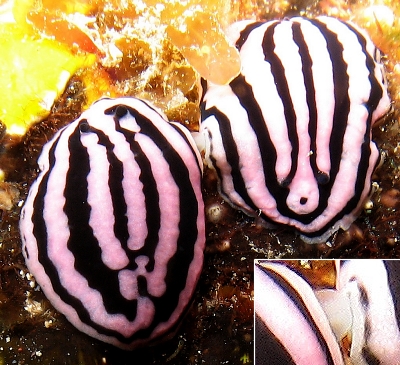
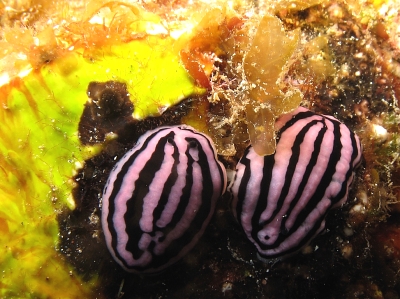
Dear Bill,
These mating Phyllidiella rosans are the same size but a little different in arrangement of the ridges. It's a new observation of a phyllidiid mating. Why are such sightings very rare?
Locality: Canyon, Saint-Gilles, 17 metres, Reunion Island, Indian Ocean, 28 november 2006. Length: 35 mm. Photographer: Hugues Flodrops.
Best regards.
Sandrine & Hugues Flodrops
hugues.flodrops@wanadoo.fr
Flodrops, S.H., 2006 (Dec 7) Phyllidiella rosans mating from Reunion Island. [Message in] Sea Slug Forum. Australian Museum, Sydney. Available from http://www.seaslugforum.net/find/18922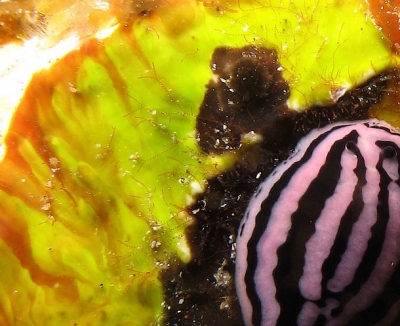
Dear Sandrine et Hugues,
I am not sure why mating observations seem to be rare for these relatively abundant animals. I assume its something to do with our observations rather than actual mating frequency because reproduction does not seem to be a problem.
One very interesting thing in your photos is the big chunk which has apparently been eaten out of the yellow sponge. It certainly looks to me as thought it has been bitten out. This is a nice confirmation of Marina Poddubetskaia's observations [message #8394] of this species eating what looks to be the same yellow sponge.
Best wishes,
Bill Rudman
Phyllidiella rosans from Reunion Island
September 5, 2006
From: Hugues Flodrops
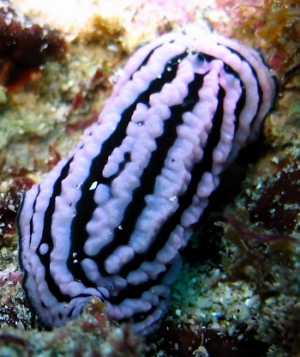
Dear Bill,
I thinks it's look like Phyllidiella zeylanica but the forms of Phyllidiella rosans are also similar. This photo looks like lower left photo of P. rosans in Marina Podduhetskaia's message [#8313]. Thanks for your precisions.
Locality: Passe de l'Hermitage, 18 metres, Reunion Island, Indian Ocean, 31 August 2006, Good weather. Length: 40 mm. Photographer: Hugues Flodrops.
Best regards,
Hugues.
hugues.flodrops@wanadoo.fr
Flodrops, H, 2006 (Sep 5) Phyllidiella rosans from Reunion Island. [Message in] Sea Slug Forum. Australian Museum, Sydney. Available from http://www.seaslugforum.net/find/17730Dear Hugues,
This is P. rosans. On the species Fact Sheet you will see a photo from Reunion Island almost identical in colour and shape. The ridges in P. zeylanica are often broken, and even in the unbroken ridges they are broken into rows of hight tubercles with spaces in between.
Best wishes,
Bill Rudman
Phyllidiella rosans from the Maldives
May 28, 2005
From: Charles Rowe
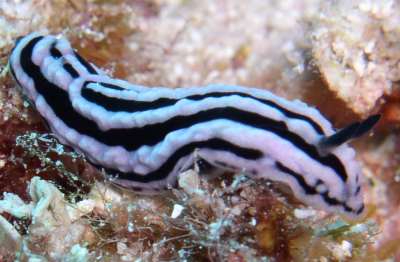
Hi Bill,
This one was taken at Kalifushivaru Out, Kuredu Island, Maldives on
23 April 2005 at 19 metres.
See ya.
Charles...
Charles.rowe@gmsa.com
Rowe, C., 2005 (May 28) Phyllidiella rosans from the Maldives. [Message in] Sea Slug Forum. Australian Museum, Sydney. Available from http://www.seaslugforum.net/find/13867Dear Charles,
I am pretty sure this is Phyllidiella rosans. It seems to be quite variable in the nature of the ridges down its mantle, in some they are continuous while in others they are broken up into short lengths.
Best wishes,
Bill Rudman
Re: Phyllidiella rosans - yellow sponge
November 9, 2002
From: Marina Poddubetskaia
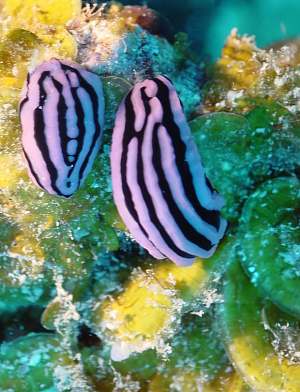
Dear Bill,
Thanks for the identification of P. meandrina. To answer your question about the yellow sponge I included a photo of two P. rosans on the same yellow-green sponge (which looks more like an algae here).
Date: October 14, 2002
Location: Pereybere, Mauritius, Indian Ocean
Site: Marengo
Depth: 13m
Size of the biggest: 25-30mm
Best wishes,
Marina.
nembro@nembro.info
Poddubetskaia, M. , 2002 (Nov 9) Re: Phyllidiella rosans - yellow sponge. [Message in] Sea Slug Forum. Australian Museum, Sydney. Available from http://www.seaslugforum.net/find/8394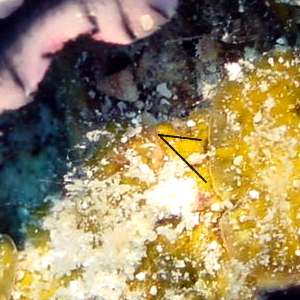
Dear Marina,
I think this is algae. I have included part of your photo from a separate message. The 'sponge' is more flattened here but you can see the edge of a layer overlapping another. I agree it sems to be an alga.
Date: October 16, 2002
Location: Pereybere, Mauritius, Indian Ocean
Site: Grand Aquarium
Depth: 10m
Size: 45-50mm
Best wishes,
Bill Rudman
Phyllidiella rosans? from Indian Ocean [1]
November 8, 2002
From: Marina Poddubetskaia
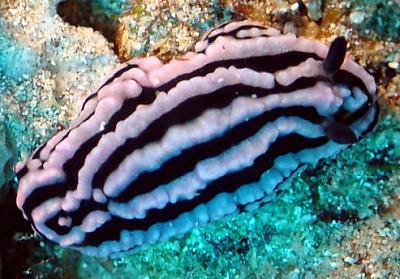
Dear Bill,
To accompany my other message Here are some photos of the other most common nudibranch of Reunion and Mauritius. I saw these phyllidiids in large numbers in all sites I dived. Under the water, they seem quite different than those I sent separately which were always larger. Is this species Phyllidiella rosans?
Upper Right: October 07, 2002, ‘Le platier de la Pointe au Sel’, St-Leu, Reunion Island, Indian Ocean. 25-30mm at 24m. Lower Left: October 09, 2002, ‘Banc de sable’, St-Leu, Reunion Island, Indian Ocean. 30-35mm at 17m. Lower Right: October 14, 2002, ‘Marengo’, Pereybere, Mauritius, Indian Ocean. 25-30mm at 16m
Photos: Marina Poddubetskaia - Nembro website
Best wishes,
Marina.
nembro@nembro.info
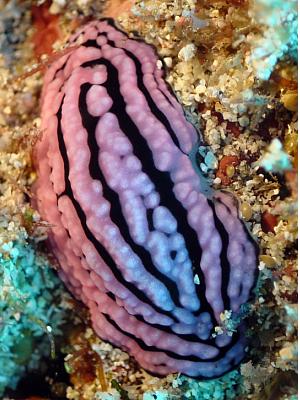
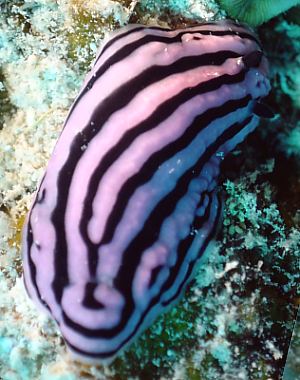
Dear Marina,
Thanks for these photos. The upper and lower right photos are the form of Phyllidiella rosans in which the tubercles are arranged in longitudinal ridges. I am not so sure about the lower left photo. I suspect that is a form of P. zeylanica.
Best wishes,
Bill Rudman
Phyllidiella rosans? from Indian Ocean [2]
November 8, 2002
From: Marina Poddubetskaia
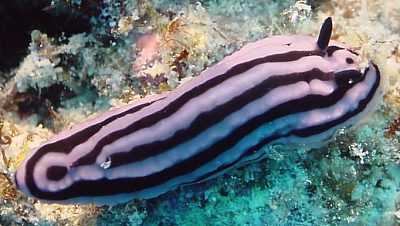
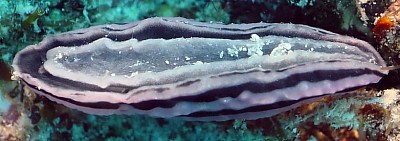
Dear Bill,
To accompany my other message here are some more photos I think are of Phyllidiella rosans.
October 15, 2002, ‘L’aquarium de Pereybere’, Pereybere, Mauritius, Indian Ocean. about 30mm at 10m. Photos: Marina Poddubetskaia - Nembro website
Best wishes,
Marina.
nembro@nembro.info
Thanks Marina,
This is definitely Phyllidiella rosans. I am curious about the locality ‘L’aquarium de Pereybere’. I assume it is not what we normally think of as an aquarium - with glass and pumps etc?
Cheers,
Bill Rudman
Phyllidiella rosans from East Africa
July 2, 2002
From: Bernard Picton
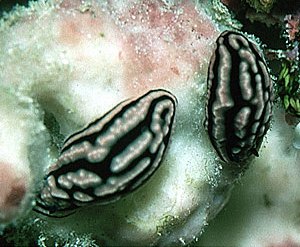
Hi Bill,
Here is another puzzling phyllidiid from East Africa. It is also from Pemba Island where I spent a week diving in Feb 1999 from the boat Kisiwani.
I think this is Phylidiella rosans - I'm very confused as to whether I also have P. zeylanica [see separate message]. Most of the pictures of P. rosans seem to show no cross-bars of black, only longitudinal bars. I've enclosed this photo which shows part of a group feeding on a sponge, all about 15mm long. The tubercles seem to be too low for P. zeylanica but more separate than P. rosans?
Bernard
bernard.picton.um@nics.gov.uk
Picton, B., 2002 (Jul 2) Phyllidiella rosans from East Africa. [Message in] Sea Slug Forum. Australian Museum, Sydney. Available from http://www.seaslugforum.net/find/6467Dear Bernard,
I am pretty sure this is P. rosans. Brunckhorst (1993) included animals which ranged from those with short longitudinal ridges as in your photo to animals with ridges running the length of the body. he considered 'smooth' non-tuberculate ridges characterised this species but from the various photos on the Forum it would seem some small tubercles, like in your photo, are part of the variability. I will discuss my views on the animals you think may be P. zeylanica in your separate message.
Best wishes,
Bill Rudman
2 Phyllidiella rosans feeding
April 27, 2001
From: Erwin Koehler
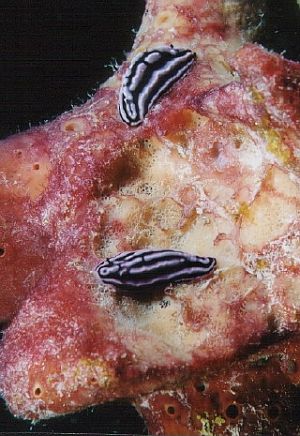
Dear Bill,
Attached is a photo from the Maldives, Kandooma Fushi Island, divesite "Kandooma Out", length about 25mm, depth 14m, Sept. 17, 2000.
It shows two Phyllidiella rosans feeding on this sponge. I often found them on it.
Erwin
Erwin@medslugs.de
Koehler, E., 2001 (Apr 27) 2 Phyllidiella rosans feeding. [Message in] Sea Slug Forum. Australian Museum, Sydney. Available from http://www.seaslugforum.net/find/4223Dear Erwin,
Thanks for the observation. I can't find any record of what sponge this species feeds on, so your photo is of great interest. Unfortunately, I suspect getting the sponge identified from a photo will be difficult.
Best wishes,
Bill Rudman
Phyllidiella rosans? from Fiji
March 9, 2001
From: Mary Jane Adams
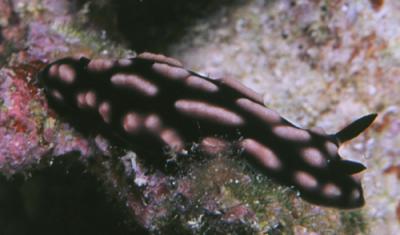
Hi Bill,
I don't know what to call this. Could it be Phyllidiella rosans ? Waykaya, Vitu Levu, Fiji, May, 1997. Length: 25 mm
Thanks!
Mary Jane
divepng@yahoo.com
Adams, M.J., 2001 (Mar 9) Phyllidiella rosans? from Fiji. [Message in] Sea Slug Forum. Australian Museum, Sydney. Available from http://www.seaslugforum.net/find/3779Dear Mary Jane,
Yes this is P. rosans.
Best wishes,
Bill Rudman
Phyllidiella rosans from Hawaii
June 10, 2000
From: Scott Johnson
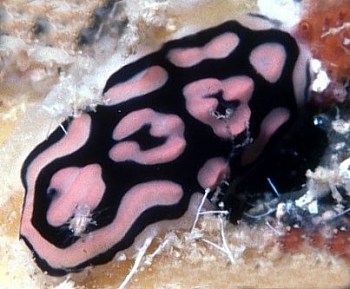
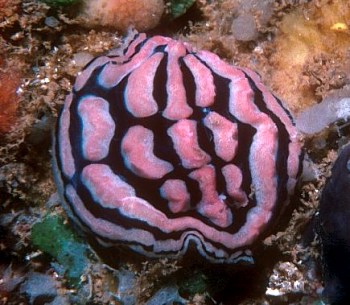
Hi Bill,
Attached are a couple of variations of Phyllidiella rosans from the Hawaiian Islands. I haven't yet seen this species in the Marshalls.
Scott
johnson@kmr.ll.mit.edu
Johnson, S., 2000 (Jun 10) Phyllidiella rosans from Hawaii. [Message in] Sea Slug Forum. Australian Museum, Sydney. Available from http://www.seaslugforum.net/find/2536Dear Scott,
Thanks for the photos. According to Brunckhorst, 1993 this has a wide Indo-West Pacific distribution but paradoxically is recorded from only a few localities. For example, I know of no records from Australia, Indonesia or the Philippines, although one would expect to find it there. If anyone has photos, they could help fill in some gaps in our knowledge of this species.
Best wishes,
Bill Rudman.
Phyllidiella rosans from Maldives
December 24, 1999
From: Eriwn Koehler
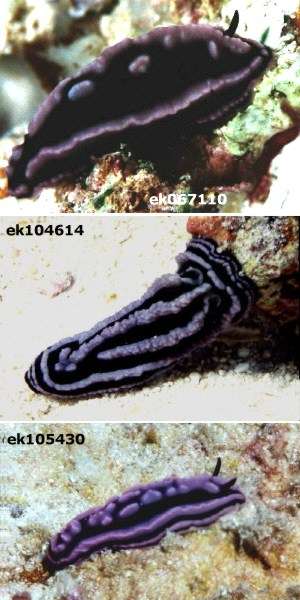
Bill,
the Phyllidiids will get me crazy. After your message about Phyllidiella granulata I reviewed my Phyllidiella rudmani from the Maldives and had to accept, that most of them are Phyllidiella zeylanica. This will be changed
tonight. I don't know why, but the print (of Phyllidiella granulata) looks pretty different from the negative (there you can see clearly two "white" lines).
So far, so good - now to the new ones from the Maldives. I think they all are Phyllidiella rosans although some of them don't fit the descriptions. The colour of the ridges varies from pale blue, dark blue,
purple, pink to grey and their tubercle ridges vary as shown. Variations I've not seen are blue ridged ones with interrupted ridges (or however this is expressed). Usually they look somehow like EK105913.
Dates:
•EK067110 Ellaidhoo Is., divesite "Cari Beyru Tila", Nov 21, 1996, size 15 mm, depth 9 m
•EK104614 Guraidhoo Is., divesite "Guraidho Kandu", Oct. 24, 1999, size 32 mm, depth 19 m
•EK105430 Kanifinolhu Is., divesite "Kani Corner", Oct. 27, 1999, 27 mm, depth 22 m
•EK105913 Lankanfinolhu Is., divesite "Nasimo Thila", Oct. 28, 1999, size 29 mm, depth 14 m
•EK106428 Meerufenfushi Is., divesite "Prisca Corner", Oct. 31, 1999, size 22 mm, depth 18 m
•EK106825 Gaafaru Is., divesite "Wreck of the Lady Christine", Nov. 01, 1999, size 34 mm, depth 6 m
•EK106903 Gaafaru Is., divesite "Iruwai Kandu", Nov. 01, 1999, size 12 mm, depth 20 m
Erwin
Medslugs.Koehler@t-online.de
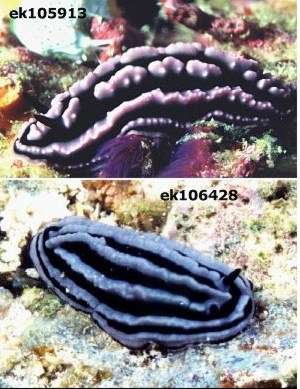
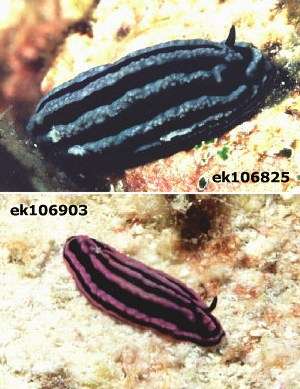
Dear Erwin,
Yes I think these are all P. rosans. I can't say phyllidiids are my favourite group to identify but I think the large series of photos you are sending will help us to better understand the variation occurring within some of these species. In the case of Phyllidiella rosans your photos suggest that the ridges vary in colour from pink to green and bluish much like in Phyllidiella pustulosa.
Sorry I have been sitting on these photos for a while. I can now go on holiday with a clear conscience.
Best wishes for Xmas and the New Year,
Bill Rudman.
